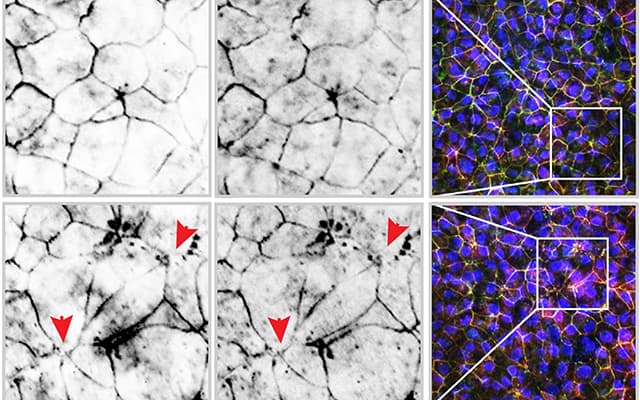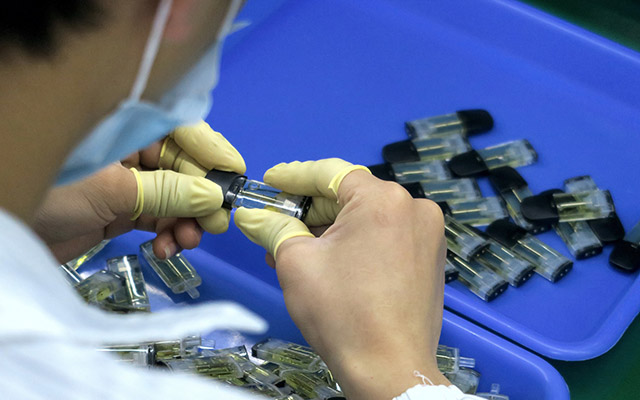Per- and polyfluoroalkyl substances (PFAS) are a class of man-made chemical compounds and a current, emerging concern to environmental health. PFAS substances have unique characteristics-resistance to heat, water, oil and stains-that make them useful in a variety of industrial applications…
Tag: TOXICOLOGY
For selenium in rivers, timing matters
Selenium contamination of freshwater ecosystems is an ongoing environmental health problem around the world. A naturally occurring trace element, selenium levels are high in some geologic formations like sedimentary shales that form much of the bedrock in the Western United…
Climate-friendly foam building insulation may do more harm than good
The use of the polymeric flame retardant PolyFR in “eco-friendly” foam plastic building insulation may be harmful to human health and the environment, according to a new commentary in Environmental Science & Technology . The authors’ analysis identifies several points…
Scientists found in marine mold substance that antidotes paraquat
Biologically active compounds from the marine fungus Penicillium dimorphosporum protect cells from paraquat, the highly toxic herbicide with no remedy, and might enhance the action of some drugs. The fungus was isolated from soft coral collected in the South China…
Potentially harmful chemicals found in plastic toys
New research suggests that more than 100 chemicals found in plastic toy materials may pose possible health risks to children.
Oil spill has long-term immunological effects in dolphins
A study published in Environmental Toxicology and Chemistry has found long-term impacts of the 2010 Deepwater Horizon oil spill in the northern Gulf of Mexico on bottlenose dolphins’ immune function. Bottlenose dolphins from an area that received prolonged and heavy…
Scientists: Chemical pollution is a global threat that needs global action
ZÜRICH, Switzerland–An international group of scientists is calling for a global intergovernmental science-policy body for informing policymakers, business, and the public about reducing harm from chemical pollution. In a paper published today in Science, the group explains how limited and…
Plastic recycling results in rare metals being found in children’s toys and food packaging
Some of the planet’s rarest metals – used in the manufacture of smartphones and other electrical equipment – are increasingly being found in everyday consumer plastics, according to new research. Scientists from the University of Plymouth and University of Illinois…
Making swimming pools safer by reducing chlorine disinfection byproducts
Swimming in indoor or outdoor pools is a healthy form of exercise and recreation for many people. However, studies have linked compounds that arise from chlorine disinfection of the pools to respiratory problems, including asthma, in avid swimmers. Now, researchers…
Perceiving predators: Understanding how plants ‘sense’ herbivore attack
How ‘elicitors’ can initiate defense responses in plants against herbivores, and can potentially lead to development of pesticide-free agriculture
George Mason, Rutgers partner to better inform HER2 breast cancer treatment
A George Mason University and Rutgers Cancer Institute of New Jersey collaboration received the U.S. Army’s Breast Cancer Research Program Breakthrough Award to indicate success likelihood of personalized HER2 biomarker breast cancer treatments
Pre-COVID subway air polluted from DC to Boston, but New York region’s is the worst
Commuters now have yet another reason to avoid packing themselves into subway stations. New York City’s transit system exposes riders to more inhaled pollutants than any other metropolitan subway system in the Northeastern United States, a new study finds. Yet…
Links between pollution and cancer in wild animals: what can we learn?
The recent review, published in Environment International and led by the University of Tartu, summarises the effect of aquatic pollution on cancer prevalence in wild animals with the help of more than 300 reviewed studies. Authors shed light on understudied…
A new vision for AAV-delivered gene therapies
A broadly applicable AAV genome-coupled immunomodulation strategy helps cloak the AAV virus from unwanted immune responses, and offers important insights into ocular inflammation
Predictive Toxicology for Healthy Children
New Approach Methodologies (NAMs) can quickly and efficiently collect a large amount of information about the potential toxicity of chemicals without the use of intact animals, but there are challenges to using them to evaluate developmental toxicity compared with adult…
Scientists discover how a group of caterpillars became poisonous
Genetic research using Smithsonian collections reveals the evolutionary path of six toxic butterfly species
Health Disparities and COVID-19, Toxicity of E-cigarette Generated Aerosols, and More Featured in February 2021 Toxicological Sciences
Toxicological Sciences continues to feature leading toxicology research in the areas of developmental and reproductive toxicology; endocrine toxicology; neurotoxicology; molecular, biochemical, and systems toxicology; and more.
Songbirds exposed to lead-contaminated water show telltale signs about human impacts
Humans, wildlife, and the environment are all interconnected and play a role in one another’s health and well-being. Sentinel species, such as birds, are good indicators of environmental health, and they can send subtle warning signs that humans may be…
Ground-breaking evidence reveals scalp cooling physically protects hair follicles
GROUND-BREAKING research from the University of Huddersfield, announced ahead of World Cancer Day 2021, proves that scalp cooling physically protects hair follicles from chemotherapy drugs. It is the world’s first piece of biological evidence that explains how scalp cooling actually…
Coral decline — is sunscreen a scapegoat?
Many household products contain ingredients to protect them against sun damage. These UV filters are found in plastics, paints and textiles, as well as personal care products such as sunscreens and moisturizers. UV filters are entering the aquatic environment in…
Combining PD-1inhibitor with VEGF inhibitor in chemotherapy of cholangiocarcinoma patient
The article by Dr. Liangshuai Liu et al. is published in Recent Patents on Anti-Cancer Drug Discovery, 2021
Toxicologists to Showcase Latest Science Affecting Public, Animal, and Environmental Health during SOT Annual Meeting and ToxExpo
With more than 65 Featured and Scientific Sessions and 1,000+ presentations showcasing advances in fundamental and translational sciences and emerging disciplines and technologies, the Virtual 2021 Annual Meeting and ToxExpo of the Society of Toxicology (SOT) is the largest forum for toxicological research in the world.
ACSL1 as a main catalyst of CoA conjugation of propionic acid-class NSAIDs in liver
Researchers from Kanazawa University find that propionic acid-class NSAIDs are conjugated with CoA by hepatic ACSL1, leading to liver toxicity via covalent binding with hepatic proteins

How to Find Mutated Sperm? Just Go FISH
A test developed by Berkeley Lab scientists can quickly and easily detect whether sperm cells are carrying chromosomal defects, an advance that will help men who have undergone cancer treatment father healthy children.

Snakes evolve a magnetic way to be resistant to venom
Certain snakes have evolved a unique genetic trick to avoid being eaten by venomous snakes, according to University of Queensland research.
Youth Using E-cigarettes Three Times as Likely to Become Daily Cigarette Smokers
University of California San Diego Herbert Wertheim School of Public Health and Human Longevity Sciences researchers report that starting tobacco products, including e-cigarettes, before the age of 18 is a major risk factor for people becoming daily cigarette smokers.
Botulism breakthrough? Taming botulinum toxin to deliver therapeutics
Treatment reverses paralysis in mice; offers a general delivery platform for neurologic drugs
How ‘Iron Man’ bacteria could help protect the environment
MSU researchers show how microbes stand up to a toxic metal, opening the door for applications in recycling and remediation

Study: E-Cigarettes Trigger Inflammation in the Gut
Chemicals used for vaping break down zipper-like junctions between cells in the gut, leading to chronic inflammation and potential for other health concerns.
Selfish elements turn embryos into a battlefield
“Nature red in tooth and claw” – The battle to survive is fought down to the level of our genes. Toxin-antidote elements are gene pairs that spread in populations by killing non-carriers. Now, research by the Burga lab at IMBA…
Treating infections in pregnant patients
Pregnancy and Anti-Infective Agents is a concise clinical reference that facilitates health consultants and professionals for determining treatment options for some common prenatal and postpartum infections during pregnancy and the puerperium in patients. Key Features Presents 9 organized, easy to…
Gene biomarkers indicate liver toxicity quickly and accurately
URBANA, Ill. ¬- When agrochemical and pharmaceutical companies develop new products, they must test extensively for potential toxicity before obtaining regulatory approval. This testing usually involves lengthy and expensive animal studies. A research team at University of Illinois has developed…
Scientists Advancing Public Health Research Honored with 2021 Society of Toxicology Awards
The Society of Toxicology is pleased to announce and recognize the 2021 SOT Award recipients whose work has improved human, animal, and environmental health and addressed diverse areas, such as environmental health disparities of underserved populations, toxicokinetics of xenobiotics, and reducing animal use in toxicity testing.
Scientists create a new phototoxic protein, SuperNova2
Scientists from Skoltech, the Institute of Bioorganic Chemistry of RAS, and the London Institute of Medical Sciences (LMS) have developed an enhanced version of SuperNova, a genetically encoded phototoxic synthesizer, that helps control intracellular processes by light exposure. The research…
Researchers discover protein function that could improve chemotherapy in the future
Chemotherapy attacks all cells in our body and not just cancer cells, which is why patients undergoing the treatment often experience side effects such as physical weakness, hair loss and nausea. However, because cancer cells divide and spread faster than…
Drinking water significant source of microplastics in human diet
Emerging environmental contaminants, both chemicals and particulates, have been a concern for risk scientists for many years. Methods for reducing health and environmental risks from particles are still evolving. Micro/nanoplastic particles are one environmental contaminant that has recently received research…
Plastics pose threat to human health
Authoritative report shows plastics, microplastics are pervasive sources of exposure to dangerous endocrine-disrupting chemicals

The Un-appeal of Banana: Liquid E-Cigarette Flavorings Measurably Injure Lungs
UC San Diego researchers report chemicals used for flavor in e-cigarette liquid negatively affect specialized proteins that support immune system.
Ocean heatwave has triggered new toxic algal blooms on the US west coast
Fishermen, swimmers and seafood enthusiasts may already know the dangers of “red tides,” but a recent study in Frontiers in Climate shows that climate change is increasing the frequency of one type of highly toxic algal bloom off the US…
Flavors added to vaping devices can damage the heart
The vape flavorings so popular with kids and young adults are cardiotoxic and disrupt the heart’s normal electrical activity, a University of South Florida Health preclinical study finds
Researchers rank various mask protection, modifications against COVID-19
Scientists tested consumer-grade masks and improvised face coverings to show how effective they can be at protecting individuals from airborne particles of similar size to those carrying SARS-CoV-2, the virus that causes COVID-19
Several U.S. populations and regions exposed to high arsenic concentrations in drinking water
Odds of exceeding maximum contaminant levels were significantly greater for water systems in the Southwest and serving Hispanic communities
New research project on environmental and safety aspects of stationary energy storage
The increasing use of battery technologies in the mobility sector and in stationary applications has been leading to increasing efforts in battery research of operational safety and battery recycling. The group led by Stefan Spirk at the Institute of Bioproducts…
Jin Kim Montclare named a fellow of the National Academy of Inventors
BROOKLYN, New York, Wednesday, December 9, 2020 – Jin Kim Montclare , professor of chemical and biomolecular engineering at the New York University Tandon School of Engineering , and director of the Montclare Lab , has been named a Fellow…
Listen to the birds: illegal diet pill DNP might kill you on the long run
Weight loss appears as a holy grail in our modern societies. DNP (2,4-dinitrophenol), a molecule decreasing the efficiency at which food is converted to cellular energy, was discovered in the early 1930s to be an efficient chemical treatment to promote…
Pervasive plastics increase exposure to harmful chemicals
The Endocrine Society and IPEN will release a comprehensive joint report Dec. 15 on endocrine-disrupting chemicals in plastics and the threat they pose to public health. Experts will share highlights from the report during a virtual news conference Dec. 15.
Simple, sensitive test helps monitor bats and protect biodiversity
Each and every biological organism has an important function in creating a healthy ecosystem, which is why conservationists everywhere encourage protecting biodiversity. However, monitoring wildlife health is an ongoing challenge. A new article in Environmental Toxicology and Chemistry explores the…
New report details links between widespread ocean pollution and human health risks
Researchers from Boston College’s Global Observatory on Pollution and Health led international coalition of scientists
Stem Cells journal paper describes breakthrough in producing neurons from stem cells
Co-authors’ company aims to provide rapid production of neurons for academic researchers and pharmaceutical developers
‘Message in a bottle’ tracks plastic pollution
Electronic tags released in the Ganges river show plastic pollution can travel thousands of kilometres in just a few months. Researchers put GPS and satellite tags in plastic bottles in the Ganges and the Bay of Bengal. The maximum distance…